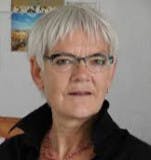I chose Kolding School of Arts and Crafts because it was a brand new school that had ambitions of collaborating closely with the Jutland textile industry.
During my studies I realized early on that my main interests were patterns, colours and textile printing – surface design rather than structure and texturality.
My goal to work with textile design changed during my studies and I developed a greater desire for freedom. After the four-year education (1968-1972) I pursued other professional challenges for a while.
In 1979 I established my own printing workshop. I solved some tasks within the area of textile design, but my focus was on one-off products, more specifically pictures. I became interested in exhibiting my work, and I have done that constantly over the years.
The shift between different expressions and work methods has always inspired me. For a while my work with large pieces was converted into curtain design for the design company Kvadrat. The picture compositions were translated into patterns, and my work with colours was applied in assignments with colour selection of spaces and buildings. Slowly my work in the visual medium moved in the direction of what I would call a mixed form and from there to the pure painting. New tools and materials changed the artistic expression as well as thematic projects.
I had to take a stand as far as my professional affiliation was concerned: Handicrafts or Pictorial Art. It was a necessary decision I had to make, and a distinction that is maintained in Denmark.
I was a guest lecturer at Design School Kolding for many years (1983 – 2004), and in that connection it was also important to send a clear signal about my own identity.
In my artistic work the journey is an important space for inspiration. Through several study visits to Rome my gaze and my inspiration moved from the designs in the church floor mosaics via the architecture of the Renaissance and the Baroque period to end up zooming in on close-ups of antique, classical sculpture. The photograph became an essential element in the sketching process, but also, to an ever greater extent, a part of the final product.
In 2005 I started working with photogravure, a classic graphic deep printing technique, which emphasises the tonality of the photograph in a unique way. It’s a technique far removed from textile printing, but it’s a craft discipline where I found a familiarity in the work process, and since then I have used it in several series both b/w and colour print.
Travelling with projects to Damascus in Syria and to Ramallah in Palestine was a profound inspiration – foreign, but open. It was a challenge converting experiences and reflections from that trip but it resulted in several work series.
Juxtaposing two or more motives is a common method in my works, a technique where reality shifts and is displaced; it is also a way of asking questions.
In 2012 I transferred my work into a book and transformed the curiosity created by the journey into a keen eye on domestic localities. The result was the photo book “Sted og Rum” (Place and Space).
My own artistic development sheds a light on the particular opportunities inherent in the design education when it comes to handling many different assignments and projects.
My own works are approaching the point of departure where compositions of colours and stripes were a part of the learning process, now challenged by painting and computer and subsequently transformed to a colour photogravure. A long process, but far from tedious.
